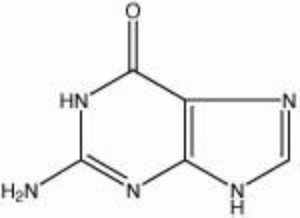Difference between revisions of "Guanine"
Jump to navigation
Jump to search
(username removed) |
|||
| (4 intermediate revisions by 3 users not shown) | |||
| Line 1: | Line 1: | ||
== Description == | == Description == | ||
| − | A purine type nucleic acid extracted from [ | + | A purine type nucleic acid extracted from [[guano]] and fish scales. Guanine crystals are rhombic platelets composed of multiple layers. They are transparent but have a high index of refraction that produces a pearly luster. Guanine is used as a nacreous pigment called [[pearl color]]. |
| − | + | [[[SliderGallery rightalign|guanine.jpg~Chemical structure]]] | |
== Synonyms and Related Terms == | == Synonyms and Related Terms == | ||
2-amino-6-oxypurine; Natural White 1; CI 75170; gaunina (Esp., Port.); pearl essence; imitation pearl; nacreous pigment; guanin; guanine enol; dew pearl; 2-amino-1,7-dihydro-6H-purin-6-one; 2-aminohypoxanthine; 2-amino hypoxanthine | 2-amino-6-oxypurine; Natural White 1; CI 75170; gaunina (Esp., Port.); pearl essence; imitation pearl; nacreous pigment; guanin; guanine enol; dew pearl; 2-amino-1,7-dihydro-6H-purin-6-one; 2-aminohypoxanthine; 2-amino hypoxanthine | ||
| − | [ | + | == Risks == |
| + | |||
| + | * Skin contact may cause irritation. | ||
| + | * Possible carcinogen. Teratogen and mutagen (animals) | ||
| + | * Fisher Scientific: [https://fscimage.fishersci.com/msds/43694.htm MSDS] | ||
| − | == | + | == Physical and Chemical Properties == |
Soluble in ammonia water, dilute bases, dilute acids. Slightly soluble in ethanol, ether. Insoluble in water. | Soluble in ammonia water, dilute bases, dilute acids. Slightly soluble in ethanol, ether. Insoluble in water. | ||
| Line 22: | Line 26: | ||
|- | |- | ||
! scope="row"| Melting Point | ! scope="row"| Melting Point | ||
| − | | 360 | + | | 360 C |
|- | |- | ||
! scope="row"| Molecular Weight | ! scope="row"| Molecular Weight | ||
| Line 28: | Line 32: | ||
|} | |} | ||
| − | == | + | ==Resources and Citations== |
| − | |||
| − | |||
| − | |||
| − | |||
| − | |||
| − | |||
| − | |||
| − | |||
| − | * | + | * G.S.Brady, ''Materials Handbook'', McGraw-Hill Book Co., New York, 1971 Comment: p. 379 |
| − | * | + | * Richard S. Lewis, ''Hawley's Condensed Chemical Dictionary'', Van Nostrand Reinhold, New York, 10th ed., 1993 |
* ''The Merck Index'', Martha Windholz (ed.), Merck Research Labs, Rahway NJ, 10th edition, 1983 Comment: entry 4593 | * ''The Merck Index'', Martha Windholz (ed.), Merck Research Labs, Rahway NJ, 10th edition, 1983 Comment: entry 4593 | ||
| − | * | + | * Coloria: http://www.coloria.net/varita.htm - NW1, CI75170, used as pigment by Francois Jaquin in 1656 |
[[Category:Materials database]] | [[Category:Materials database]] | ||
Latest revision as of 08:43, 23 August 2022
Description
A purine type nucleic acid extracted from Guano and fish scales. Guanine crystals are rhombic platelets composed of multiple layers. They are transparent but have a high index of refraction that produces a pearly luster. Guanine is used as a nacreous pigment called Pearl color.
Synonyms and Related Terms
2-amino-6-oxypurine; Natural White 1; CI 75170; gaunina (Esp., Port.); pearl essence; imitation pearl; nacreous pigment; guanin; guanine enol; dew pearl; 2-amino-1,7-dihydro-6H-purin-6-one; 2-aminohypoxanthine; 2-amino hypoxanthine
Risks
- Skin contact may cause irritation.
- Possible carcinogen. Teratogen and mutagen (animals)
- Fisher Scientific: MSDS
Physical and Chemical Properties
Soluble in ammonia water, dilute bases, dilute acids. Slightly soluble in ethanol, ether. Insoluble in water.
| Composition | C5H5H5O |
|---|---|
| CAS | 73-40-5 |
| Melting Point | 360 C |
| Molecular Weight | mol. wt. = 151.13 |
Resources and Citations
- G.S.Brady, Materials Handbook, McGraw-Hill Book Co., New York, 1971 Comment: p. 379
- Richard S. Lewis, Hawley's Condensed Chemical Dictionary, Van Nostrand Reinhold, New York, 10th ed., 1993
- The Merck Index, Martha Windholz (ed.), Merck Research Labs, Rahway NJ, 10th edition, 1983 Comment: entry 4593
- Coloria: http://www.coloria.net/varita.htm - NW1, CI75170, used as pigment by Francois Jaquin in 1656
